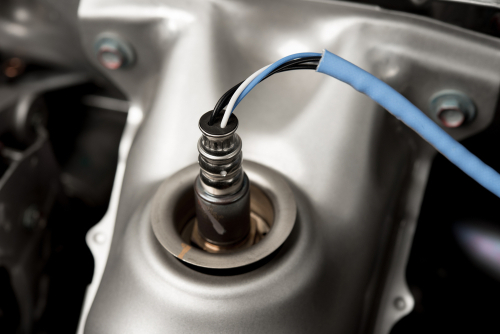Is your check engine light on? You might be dealing with the P0043 diagnostic trouble code. Don’t worry, we’ve got you covered!

P0043 indicates a problem with the heating element in your oxygen sensor, specifically Bank 1 Sensor 3. This little gizmo plays a crucial role in keeping your engine running smoothly and efficiently. When it’s not working right, your car might start acting up.
You might notice poor fuel economy, rough idling, or even stalling. But fear not! With a bit of know-how and some elbow grease, you can tackle this issue head-on. Let’s dive into what this code means, how to diagnose it, and what you can do to get your ride back in tip-top shape.
Key Takeaways
- P0043 relates to a faulty oxygen sensor heater circuit in your vehicle’s exhaust system
- Common symptoms include reduced fuel efficiency, rough idling, and potential engine misfires
- Diagnosis often involves checking wiring, replacing the oxygen sensor, or addressing PCM issues
Understanding the Basics
Hey there, gear head! Let’s dive into the nitty-gritty of P0043. You know that feeling when your check engine light comes on? Well, this code might be the culprit.
P0043 is all about your heated oxygen sensor (HO2S) throwing a fit. This little gizmo sits in your exhaust system, sniffing out the air-fuel mixture like a mechanical bloodhound.
Now, here’s the kicker: Bank 1, Sensor 3. Think of your engine as a bank, and the sensors are like tellers. This particular teller is feeling a bit chilly because its heater circuit is running low on juice.
Why heat an oxygen sensor, you ask? Well, these sensors work best when they’re nice and toasty. It’s like how you function better after your morning coffee.
Your engine control module (ECM) is the brains of the operation. When it notices the heater circuit isn’t up to snuff, it throws this code faster than you can say “carburetor.”
Here’s a quick breakdown:
- HO2S: Heated Oxygen Sensor
- Bank 1: The side of the engine with cylinder #1
- Sensor 3: Usually after the catalytic converter
- Heater Circuit: Keeps the sensor at optimal temperature
Remember, optimal combustion is the name of the game. Your HO2S helps keep that air-fuel mixture in perfect harmony, like a well-tuned guitar.
Deciphering the Code P0043

Alright, buckle up, gear heads! Let’s dive into the mysterious world of the P0043 trouble code. It’s like your car’s way of saying, “Hey, I’m feeling a bit chilly down here!”
This pesky code pops up when your vehicle’s ECM (that’s Engine Control Module for you newbies) detects a low voltage condition in the HO2S heater control circuit. Now, don’t let those fancy words scare you – HO2S just means Heated Oxygen Sensor.
Think of it like this: your oxygen sensor is feeling lazy and doesn’t want to warm up properly. It’s like trying to start your day without a cup of coffee – things just don’t work right!
Here’s a quick breakdown of what P0043 means:
- P: Powertrain (engine and transmission)
- 0: Generic OBD-II code
- 043: Specific fault index
The “Bank 1, Sensor 3” part? That’s just telling you which sensor is throwing a fit. It’s like knowing which of your kids is causing trouble – handy information!
Remember, this diagnostic trouble code is your car’s way of asking for help. It’s saying, “Hey, my heater element circuit is feeling a bit under the weather.” Don’t ignore it, or you might end up with more than just a chilly sensor!
Common Symptoms and Causes

Hey there, fellow gearhead! Let’s dive into the nitty-gritty of P0043. You might notice your trusty steed acting a bit odd when this code pops up.
First off, that pesky check engine light will likely be glowing like a Christmas tree. Don’t ignore it, folks!
Your ride might start chugging gas like there’s no tomorrow. Decreased fuel efficiency is a common symptom, so keep an eye on those fill-ups.
Feeling a bit shaky? Rough idling could be your engine’s way of crying for help. It’s like it’s had one too many coffees!
Here’s a fun one: You might fail your emissions test. Talk about embarrassing! It’s like your car forgot its deodorant.
Common Causes:
- Exhaust leak (your car’s version of bad breath)
- Corrosion (rust never sleeps, especially on sensors)
- Wiring harness issues (tangled wires, anyone?)
- Ground problems (electrical gremlins at work)
Remember, your oxygen sensor is working overtime in a pretty harsh environment. It’s like asking you to work in a sauna 24/7 – something’s bound to go wrong eventually!
Keep your ears open for any unusual exhaust noises too. If your car starts sounding like a dragon with indigestion, you might have an exhaust leak on your hands.
Diagnosis and Repair
You’ve got a P0043 code, eh? Time to roll up those sleeves and get to work on your heated oxygen sensor. Don’t worry, it’s not as scary as it sounds!
First things first, check that fuse. It’s amazing how often a simple blown fuse can make your car throw a fit. If the fuse is fine, it’s time to get your hands dirty.
Grab your trusty multimeter and do a resistance test on the sensor. If it’s reading higher than specs, you might be looking at a faulty sensor. Easy peasy, just swap it out!
But wait, there’s more! Don’t forget to inspect those wiring and connectors. Corrosion and damage can wreak havoc on your HO2S heater control circuit. A little cleaning or repair might be all you need.
On a scale of 1 to 10, the repair difficulty is about a 6. It’s not rocket science, but you’ll need some basic tools and know-how. As for importance? Let’s call it an 8. Ignoring it could lead to poor fuel economy and increased emissions.
If all this sounds like Greek to you, don’t fret! Your local mechanic can diagnose and fix this issue faster than you can say “catalytic converter”. Remember, a stitch in time saves nine – or in this case, saves your wallet from a bigger repair down the road.
The Impact on Your Wallet
Got a P0043 code? Brace yourself, because your wallet might feel a bit lighter soon. Let’s break down the costs you’re looking at.
First up, you’ll need an OBD-2 scanner to confirm the code. If you don’t have one, that’s about $50-$100 right there. But hey, it’s a good investment for future DIY diagnostics!
Now, the meat and potatoes – fixing the issue. The cost can vary depending on what’s causing the problem:
- Replacing oxygen sensors: $200-$500
- Wiring repairs: $100-$300
- New catalytic converter (worst-case scenario): $500-$2500
Don’t forget about labor costs! Mechanics usually charge $80-$150 per hour. Ouch!
But here’s a silver lining: sometimes, you might just need to clear the code and see if it comes back. That’s free if you’ve got a scanner!
Remember, ignoring P0043 could lead to failed emissions tests and decreased fuel efficiency. In the long run, that’ll cost you more than fixing it now.
So, while your wallet might groan a bit, think of it as an investment in your car’s health. Plus, you’ll be doing your part for the environment. Win-win, right?
Frequently Asked Questions
Let’s dive into some common queries about the P0043 code and oxygen sensor issues. These questions will help unravel the mysteries of heater control circuits, sensor locations, and diagnostic steps.
Can you enlighten us on what triggers a ‘heater control circuit low’ condition?
A ‘heater control circuit low’ condition typically occurs when the voltage in the oxygen sensor’s heating element drops below the expected range. This can happen due to a faulty sensor, damaged wiring, or a malfunctioning engine control module (ECM).
Your car’s computer expects to see a certain voltage level in this circuit. When it detects a lower-than-normal reading, it throws a fit and lights up your dashboard like a Christmas tree.
Where would you find the notorious Bank 1 Sensor 3 oxygen sensor in your vehicle?
Bank 1 Sensor 3 is usually located downstream of the catalytic converter on the exhaust system. In most vehicles, it’s the last oxygen sensor before the muffler.
You’ll need to channel your inner contortionist to spot this elusive sensor. It’s often tucked away like a shy groundhog, requiring some serious under-car acrobatics to access.
What pesky issues might one face when the HO2S heater control circuit decides to act up?
When your HO2S heater control circuit goes on strike, you might notice a few annoying symptoms. Your engine could start running rough, like it’s had one too many oil martinis.
You might also see a dip in fuel efficiency, as if your car suddenly developed an expensive drinking habit. In some cases, you could fail an emissions test, making your vehicle persona non grata at the DMV.
How can you tell if your vehicle’s heater control circuit is just being moody or is truly in need of repair?
To determine if your heater control circuit is genuinely on the fritz, you’ll need to put on your detective hat. First, check for any visible damage to the wiring or connectors.
Next, use a multimeter to test the voltage at the sensor. If it’s lower than specified, you might have a real problem on your hands. Remember, a proper diagnosis often requires a scan tool to read live data from the sensor.
Might you divulge the secret whereabouts of the Bank 1 Sensor 1 for those of us not in the know?
Ah, the elusive Bank 1 Sensor 1! This oxygen sensor is typically located before the catalytic converter on the exhaust manifold. It’s like the bouncer of the exhaust system, checking IDs before letting gases into the cat.
In most engines, you’ll find it near the front of the vehicle, often peeking out from the engine bay like a curious meerkat. It’s usually easier to spot than its downstream cousins.
When your motor chariot throws a P0043 code at you, what steps would you take to diagnose this enigmatic message?
When faced with the P0043 code, start by checking the obvious culprits. Inspect the wiring and connectors for any signs of damage or corrosion. These can be sneaky troublemakers.
Next, use a multimeter to test the heater circuit resistance. If it’s out of spec, you might need to replace the sensor. Don’t forget to check the fuse box too – sometimes a blown fuse can be the root of all evil.
